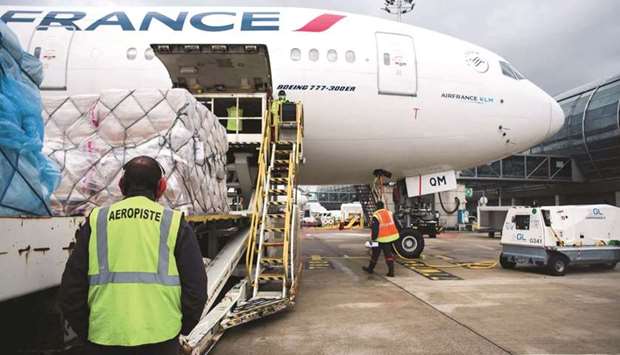Air cargo is a key driver of global economic development, facilitating trade and creating millions of jobs worldwide.
It helps countries contribute to the global economy by increasing access to international markets and allowing the globalisation of production.
To maintain growth momentum, the global economy requires delivery of high-quality products at competitive prices to consumers worldwide.
Air cargo transports more than $6tn worth of goods, accounting for approximately 35% of world trade by value.
The significance of air cargo is perhaps best illustrated in the supply of much-needed Covid vaccines and other essential lifesaving drugs around the world, every single day!
Because of supply chain solutions, vaccines can reach their destination in time to be effective.
The World Health Organisation estimates that immunisation programmes prevent up to 3mn child deaths every year.
Air cargo is critical in flying these temperature-sensitive pharmaceuticals in the best conditions, using cutting-edge technologies and procedures.
Air cargo also helps people stay connected – some 328bn letters and 7.4bn postal parcels are sent every year and airmail plays an essential role in their delivery!
While the emergence of electronic communications caused a dramatic decrease in the number of letters sent, more and more parcels are being delivered daily thanks to e-commerce.
Recent data that air cargo demand continued to outperform pre-Covid levels (April 2019) with demand up 12%, has cheered up the global air transport industry.
Global demand, measured in cargo tonne-kilometres (CTKs), was up 12% compared to April 2019 and 7.8% compared to March 2021, data provided by global body of airlines – IATA show. Seasonally adjusted demand is now 5% higher than the pre-crisis August 2018 peak.
The strong performance was led by North American carriers contributing 7.5 percentage points to the 12% growth rate in April. Airlines in all other regions except for Latin America also supported the growth.
Middle Eastern carriers led by GCC-based carriers posted a 15.3% rise in international cargo volumes in April 2021 versus April 2019. This was a significant improvement compared to the previous month. Seasonally adjusted volumes remain on a robust upward trend. International capacity in April was down 17.5% compared to the same month in 2019.
Capacity remains 9.7% below pre-Covid-19 levels (April 2019) due to the ongoing grounding of passenger aircraft. Airlines continue to use dedicated freighters to plug the lack of available belly capacity.
International capacity from dedicated freighters rose 26.2% in April 2021 compared to the same month in 2019, while belly-cargo capacity dropped by 38.5%.
Underlying economic conditions and favourable supply chain dynamics remain supportive for air cargo. Prominent among those was the fact that global trade rose 4.2% in March.
Competitiveness against sea shipping has improved. Air cargo rates have stabilised since reaching a peak in April 2020, while shipping container rates have remain relatively high in comparison.
Meanwhile, longer supplier delivery times as economic activity ramps up make the speed of air cargo an advantage by recovering some of the time lost in the production process.
“Air cargo continues to be the good news story for the air transport sector. Demand is up 12% on pre-crisis levels and yields are solid. Some regions are outperforming the global trend, most notably carriers in North America, the Middle East and Africa. Strong air cargo performance, however, is not universal. The recovery for carriers in the Latin American region, for example, is stalled,” said Willie Walsh, IATA’s Director General.
Air transport is a driver of global trade and e-commerce, allowing globalisation of production. Aviation’s advantage over other modes of transport in terms of speed and reliability has contributed to the market for “same-day” and “next-day” delivery services and transportation of urgent or time-sensitive goods.
Some 87% of business-to-consumer (B2C) e-commerce parcels are currently carried by air.
The e-commerce share of scheduled international mail tonne kilometres (MTKs) grew from 16% to 83% between 2010 and 2016 and is estimated to grow to 91% by 2025.
That said, the biggest problem for air cargo is the lack of capacity as much of the passenger fleet remains grounded. Air cargo demand peaks towards the end of the year. That will likely be exaggerated with shoppers relying on e-commerce – 80% of which is delivered by air.
The capacity crunch from the grounded aircraft, post-pandemic, will hit particularly hard as the world is now in search for capacity for continued vaccine deliveries around the world.
A high value industry, air cargo is critical for serving markets that demand speed and reliability for the transport of goods. The highest value commodities, including computing equipment, machinery and electrical equipment, account for the highest share of airborne trade tonnage versus their share of containership tonnage.
* Pratap John is Business Editor at Gulf Times. Twitter handle: @PratapJohn

Workers load cargo into the hold of a Boeing Co 777-300ER passenger plane, operated by Air France-KLM, before departure to Los Angeles, at Charles de Gaulle airport in Roissy, France, on May 10. Recent data that air cargo demand continued to outperform pre-Covid levels (April 2019) with demand up 12%, has cheered up the global air transport industry.
